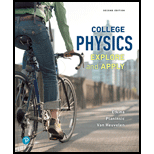
Concept explainers
24.1 and 24.2 Young’s double-slit experiment and Index of refraction, light speed, and wave coherence
Sound from speakers Sound of frequency 680 Hz is synchronized as it leaves two speakers that are separated by 0.80 m on an open field. Draw a sketch of this arrangement and draw a line from between the speakers to a location where the sound is intense and equidistant from the two speakers (the 0th order maximum). Determine the angular deflection of a line from between the speakers to the 1st order intensity maximum to the side of this 0th order maximum. The speed of sound is 340 m/s.
Want to see the full answer?
Check out a sample textbook solution
Chapter 24 Solutions
College Physics
Additional Science Textbook Solutions
Physics: Principles with Applications
Introduction to Electrodynamics
University Physics Volume 1
College Physics: A Strategic Approach (4th Edition)
Conceptual Physical Science (6th Edition)
Tutorials in Introductory Physics
- Redlaser light (wavelength = 658nm) passes through a double slit, and the slits are spaced 2.1x10-4m apart. a.Predict the distance between adjacent bright fringes when the light hits a screen positioned 5.0m away from the slits. b.Determine the angle of the 3rd nodal line c.Determine the angle of the 2nd line of constructive interferencearrow_forwardIf parallel light falls on a single slit of width D at a28.0° angle to the normal, describe the diffraction patternarrow_forward1- Describe (in detail) the interference pattern that theory predicts would have appeared on the screen 2- Explain what the single slit does to the light source and why it must be present to the left of the double slit in order to see a clear pattern on the screen.arrow_forward
- Which of the following statements are true statements about Young's double slit experiment? A. Young's experiment provided evidence that light exhibits particle-like behavior, B. Young's experiment depends upon the use of white light from two sources. C. The two sources of light in Young's experiment could be two different light bulbs. D.For Young's condition for constructive and destructive interference to be geometrically valid, the wavelength of the light must be comparable or greater than the slit separation distance. E. Thomas Young was able to determine the wavelength of a light wave.arrow_forward6. Young's double slit experiment produced a pattern where bright spots are separated by 2.5 mm. If the distance from the slits to the screen doubled, and the wavelength were tripled, what would the new spacing be? a. 1.67 mm b. 3.75 mm c. 15.0 mm d. 0.417 mm e. 3.50 mmarrow_forwardWave Diffraction What do you think would happen if you made the spacing between the slits smaller than the size of the wavelength? What will happen if the spacing between the slits is greater than the size of the wavelength?arrow_forward
- TSN-3 Two speakers 4.00m apart sit against the middle of one wall of a room that measures 10.0m by 30.0m. They produce sound with a wavelength of 0.900m a) What is the difference in path length for the waves from the two speakers that arrive at point C in the corner of the room as shown to the right? b) Trung stands against the right-hand wall at point O directly in front of the two speakers. If Trung starts walking toward corner C, how many maxima will he hear after leaving point O before he reaches point C? Ignore the effect of reflections from the walls, floor, and ceiling. Ar Clearly explain your answer in terms of 2 c) Trung again stands against the right-hand wall at point o directly in front of the two speakers. If Trung starts walking toward corner C, how many minima will he hear before he reaches point C? Ignore the effect of reflections from the 2.00m 2.00m. Ar walls, floor, and ceiling. Clearly explain your answer in terms of 10.0m 1₂ Point C 15.0m 15.0m Warrow_forwardSingle-slit Diffraction Diffraction Destructive interference for a single slit A single slit diffraction experiment uses 525 nm light falling on a slit of width 0.7 micrometers. At what angle in degrees will the first minimum be? a sin = mà for m = ±1, +2, +3.... Intensity Skill: Use the single-slit diffraction equation to solve for slit width. (a) (b) Figure 4.3 Single-sit diffraction pattern. (a) Monochromatic light passing through a single sit has a central maximum and mary smaller and dim d dimmer maxima on either side. The central maximum is six times higher than shown. (b) The diagram shows the bright cantral maximum, and the dimmer and thinner maxima on either side.arrow_forwardWaves and Optics What is the phase difference when a green laser (700nm) travels in 7 meters?arrow_forward
- Using a diffraction grating with 5000 lines/cm, the third order of a wavelength appears at 8º. Determine the frequency of the wave and at what angle the first order will appear. 9-Tarrow_forwardSlits and Diffraction 1) Use ideas from Waves Interference about what happens to waves passing through slits to help make sense of why light passing through a round hole makes a pattern. Explain what is happening\ 2)Compare patterns of varying slit size to patterns of varying hole size.3)Compare patterns of varying frequency through slits to patterns of varying wavelength through holesarrow_forwardYou reproduce Young's experience using a helium-neon laser. A) Describe the editing of this experiment B) Describe the possible interference boss you see on your screen C) Suppose the distance between five black fringes is 2.1 cm, the distance from the screen is 2.5 m and the distance between the two slots is 0.30 mm, determines the wavelength and the Laser colour. Please help me with this.arrow_forward
 Glencoe Physics: Principles and Problems, Student...PhysicsISBN:9780078807213Author:Paul W. ZitzewitzPublisher:Glencoe/McGraw-Hill
Glencoe Physics: Principles and Problems, Student...PhysicsISBN:9780078807213Author:Paul W. ZitzewitzPublisher:Glencoe/McGraw-Hill
